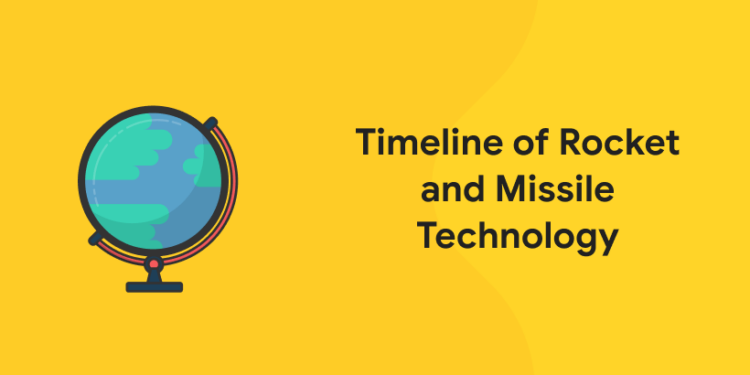Table of Contents
The availability of black powder (gunpowder) to propel projectiles was a precursor to the development of the first solid rocket. Ninth century Chinese Taoist alchemists invented black powder while searching for the Elixir of life; this invention led to experiments in the form of weapons such as bombs, cannon, incendiary fire arrows and rocket-propelled fire arrows.11th century
- 11th century AD – The first documented record of gunpowder and the fire arrow, an early form of rocketry, appears in the Chinese text Wujing Zongyao.
Grab latest study materials! Register here..
Missiles technology
Attempt GK quiz, Download Entri App
17th century ~ 19th century
1: Who was the first woman President of India?
- 1633 – Lagâri Hasan Çelebi launched a 7-winged rocket using 50 okka (140 lbs) of gunpowder from Sarayburnu, the point below Topkapı Palace in Istanbul.
- 1650 – Artis Magnae Artilleriae pars prima (“Great Art of Artillery, the First Part”) is printed in Amsterdam, about a year before the death of its author, Kazimierz Siemienowicz.
- 1664 – A “space rocket” is imagined as a future technology to be studied in France and its drawing is ordered by French finance minister Colbert; designed by Le Brun on a Gobelins tapestry (see: French space program)
- 1798 – Tipu Sultan, the King of the state of Mysore in India, develops and uses iron rockets against the British Army (see Mysorean rockets).
- 1801 – The British Army develops the Congreve rocket based on weapons used against them by Tipu Sultan.
- 1806 – Claude Ruggieri, an Italian living in France, launched animals on rockets and recovered them using parachutes. He was prevented from launching a child by police.
- 1813 – “A Treatise on the Motion of Rockets” by William Moore – first appearance of the rocket equation
- 1818 – Henry Trengrouse demonstrates his rocket apparatus for projecting a lifeline from a wrecked ship to the shore, later widely adopted
- 1844 – William Hale invents the spin-stabilized rocket
- 1865 – Jules Verne publishes From the Earth to the Moon as a humorous science fantasy story about a space gun launching a manned spacecraft equipped with rockets for landing on the Moon, but eventually used for another orbital maneuver.
Attempt GK quiz, Download Entri App
20th century
- 1902 – French cinema pioneer Georges Méliès directs A Trip to the Moon, the first movie about space travel.
- 1903 – Konstantin Tsiolkovsky begins a series of papers discussing the use of rocketry to reach outer space, space suits, and colonization of the solar system. Two key points discussed in his works are liquid fuels and staging.
- 1913 – Without knowing the work of Russian mathematician Konstantin Tsiolkovsky, French engineer Robert Esnault-Pelterie derived the equations for space flight, produced a paper that presented the rocket equation and calculated the energies required to reach the Moon and nearby planets.
- 1922 – Hermann Oberth publishes his scientific work about rocketry and space exploration: Die Rakete zu den Planetenräumen (“By Rocket into Planetary Space”).
- 1924 – Society for Studies of Interplanetary Travel founded in Moscow by Konstantin Tsiolkovsky, Friedrich Zander and 200 other space and rocket experts
- 1926 – Robert Goddard launches the first liquid fuel rocket.
- 1927 – Verein für Raumschiffahrt (VfR – “Spaceflight Society”) founded in Germany.
- 1929 – Woman in the Moon, considered to be one of the first “serious” science fiction films.
- 1931 – Friedrich Schmiedl attempts the first rocket mail service in Austria
- 1935 – Emilio Herrera Linares from Spain designed and made the first full-pressured astronaut suit, called the escafandra estratonáutica. The Russians then used a model of Herrera’s suit when first flying into space of which the Americans would then later adopt when creating their own space program.
- 1937 – Peenemunde Army Research Center founded in Germany
- 1938 – The Projectile Development Establishment founded at Fort Halstead for the United Kingdom’s research into military solid-fuel rockets.
- 1939 – Katyusha multiple rocket launchers (Russian: Катюша) are a type of rocket artilliary first built and fielded by the Soviet Union.
- 1941 – French rocket EA-41 is launched, being the first European liquid propellant working rocket[5]
- 1941 – Jet Assisted Take Off JATO installed on US Army Air Corp Ercoupe aircraft occurred on 12 August in March Field, California.
- 1942 – Wernher Von Braun and Walter Dornberger launch the first V-2 rocket at Peenemünde in northern Germany.
- 1942 – A V-2 rocket reaches an altitude of 85 km.
- 1944 – The V-2 rocket MW 18014 reaches an altitude of 176 km, becoming the first man-made object in space.
- 1945 – Lothar Sieber dies after the first vertical take-off manned rocket flight in a Bachem Ba 349 “Natter”
- 1945 – Operation Paperclip takes 1,600 German rocket scientists and technicians to the United States
- 1945 – Operation Osoaviakhim takes 2,000 German rocket scientists and technicians to the Soviet Union
- 1946 – First flight of the Nike Missile, later the first operationalsurface-to-air guided missile.
- 1947 – Chuck Yeager achieves the first manned supersonic flight in a Bell X-1 rocket-powered aircraft
- 1949 – Willy Ley publishes The Conquest of Space
- 1952 – 22 May, French Véronique 1 rocket is launched from the Algerian desert.
- 1952 – Wernher von Braun discusses the technical details of a manned exploration of Mars in Das Marsprojekt.
- 1953 – Colliers Magazine publishes a series of articles on man’s future in space, igniting the interest of people around the world. The series includes numerous articles by Ley and von Braun, illustrated by Chesley Bonestell.
- 1956 – First launch of PGM-17 Thor, the first US ballistic missile and forerunner of the Delta space launch rockets
- 1957 – Launch of the first ICBM, the USSR’s R-7 (8K71), known to NATO as the SS-6 Sapwood.
- 1957 – The USSR launches Sputnik 1, the first artificial satellite.
- 1958 – The U.S. launches Explorer 1, the first American artificial satellite, on a Jupiter-C rocket.
- 1958 – US launches their first ICBM, the Atlas-B (the Atlas-A was a test article only).
- 1961 – the USSR launches Vostok 1, Yuri Gagarin reached a height of 327 km above Earth and was the first man to orbit earth.
- 1961 – US, a Mercury capsule named Freedom 7 with Alan B. Shepherd, spacecraft was launched by a Redstone rocket on a ballistic trajectory suborbital flight.
- 1962 – The US launches Mercury MA-6 (Friendship 7) on an Atlas D booster, John Glenn finally puts America in orbit.
- 1963 – The USSR launches Vostok 6, Valentina Tereshkova was the first woman (and first civilian) to orbit earth. She remained in space for nearly three days and orbited the earth 48 times.
- 1963 – US X-15 rocket-plane, the first reusable manned spacecraft (suborbital) reaches space, pioneering reusability, carried launch and glide landings.
- 1965 – USSR Proton rocket, highly successful launch vehicle with notable payloads, Salyut 6 & Salyut 7, Mir & ISS components
- 1965 – Robert Salked investigates various single stage to orbit spaceplane concepts
- 1966 – USSR Luna 9, the first soft landing on the Moon
- 1966 – USSR launches Soyuz spacecraft, longest-running series of spacecraft, eventually serving Soviet, Russian and International space missions.
- 1969 – US Apollo 11, first men on the Moon, first lunar surface extravehicular activity.
- 1981 – US space shuttle pioneers reusability and glide landings
- 1998 – US Deep Space 1 is first deep space mission to use an ion thruster for propulsion.
- 1998 – Russia launch Zarya module which is the first part of the International Space Station.
Grab latest study materials! Register here..
21st century
- 2001 – Russian Soyuz spacecraft sent the first space tourist Dennis Tito to International Space Station.
- 2004 – US-based, first privately developed, manned (suborbital) spaceflight, SpaceShipOne demonstrates reusability.
- 2008 – SpaceX—with their Falcon 1 rocket—became the first private entity to successfully launch a rocket into orbit.
Grab latest study materials! Register here..
- 2012 – The SpaceX Dragon space capsule—launched aboard a Falcon 9 launch vehicle—was the first private spacecraft to successfully dock with another spacecraft, and was also the first private capsule to dock at the International Space Station.
- 2014 – First booster rocket returning from an orbital trajectory to achieve a zero-velocity-at-zero-altitude propulsive vertical landing. The first-stage booster of Falcon 9 Flight 9 made the first successful controlled ocean soft touchdown of a liquid-rocket-engine orbital booster on April 18, 2014.
- 2015 – SpaceX‘s Falcon 9 Flight 20 was the first time that the first stage of an orbital rocket made a successful return and vertical landing.
- 2017 – SpaceX‘s Falcon 9 SES-10 was the first time a used orbital rocket made a successful return













